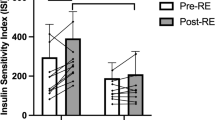Summary
Some effects of isometric exercise were studied in fast rectus femoris muscle and slow soleus muscle of the male rat. Isometric twitch contraction time did not change in both muscles, however, maximum tetanic tension increased in the fast muscle. Changes in the enzyme activity pattern of energy supplying metabolism of the rectus femoris muscle consisted in an increase of creatine kinase and citrate synthetase and a decrease of mitochondrial glycerolphosphate dehydrogenase. Treatment with Nandrolone Decanoate caused much smaller changes in male than observed in the preceding study on female rats. There was a higher performance of the trained animals under the influence of the hormone, but no changes could be found in the activities of the investigated enzymes. Combination of training with hormone treatment led to no further increase of maximal tetanic tension of the rectus femoris. Training and hormone treatment together caused an increase in glycogen phosphorylase and prevented partially the decrease in mitochondrial glycerolphosphate dehydrogenase observed under training alone. Some of the changes seen in the rectus femoris muscle after training were comparable to those in the female rats. Neither training nor hormone treatment induced changes in the male soleus muscle, except for the increase of soluble protein in sedentary hormone treated animals.
Similar content being viewed by others
References
Bass, A., Brdiczka, D., Eyer, P., Hofer, S., Pette, D.: Metabolic differentiation of distinct muscle types at the level of enzymatic organization. Europ. J. Biochem.10, 198–206 (1969)
Bass, A., Gutmann, E., Hanzliková, V., Hájek, I., Syrový, I.: The effect of castration and denervation upon the contraction properties and metabolism of the levator ani muscle of the rat. Physiol. bohemoslov.18, 177–194 (1969)
Bass, A., Gutmann, E., Hanzliková, V., Syrový, I.: Sexual differentiation of enzyme pattern and its conversion by testosterone in the temporal muscle of the guinea pig. Physiol. bohemoslov.20, 423–431 (1971)
Burke, R. E., Levine, D. N., Zajac, F. E. III, Tsairis, P., Engel, W. K.: Mammalian motor units: Physiological-histochemical correlation in three types in cat gastrocnemius. Science174 709–712 (1971)
Danforth, W. H.: Activation of glycolytic pathway in muscle. In: Control of energy metabolism, pp. 287–297. Eds. B. Chance, R. W. Estabrook, and J. R. Williamson. New York-London: Academic Press 1965
Exner, G. U., Staudte, H. W., Pette, D.: Isometric training of rats—Effects upon fast and slow muscle and modification by an anabolic hormone (nandrolone decanoate). I. Female rats. Pflügers Arch.345 1–14 (1973)
Gutmann, E.: Nervous and hormonal mechanism in the aging process. Exp. Geront.5, 357–366 (1970)
Gutmann, E., Hanzliková, V., Lojda, Z.: Effect of androgens on histochemical fibre type. Histochemie24, 287–291 (1970)
Gutmann, E., Melichna, J., Syrový, I.: Developmental changes in contraction time and muscle fibre pattern of fast and slow muscles. Experientia (Basel)29, 435–436 (1973)
Hirche, H., Wacker, U., Langohr, H. D.: Lactic acid formation in the working gastrocnemius of the dog. Int. Z. angew. Physiol.30, 52–64 (1971)
Hultman, E.: Studies on muscle metabolism of glycogen and active phosphate in man with special reference to exercise and diet. Scand. J. clin. Lab. Invest.19, Suppl. 84 (1967)
Karlsson, J., Saltin, B.: Oxygen deficit and muscle metabolites in intermittent exercise. Acta physiol. scand.82, 115–123 (1971)
Karpatkin, S., Helmreich, E., Cori, C. F.: Regulation of glycolysis in muscle. II. Effect of stimulation and epinephrine in isolated frog sartorius muscle. J. biol. Chem.239, 3139–3145 (1964)
Staudte, H. W., Exner, U., Pette, D.: unpublished results (1973)
Turner, D. C., Wallimann, T., Eppenberger, H. M.: A protein that binds specifically to the M-line of skeletal muscle is identified as the muscle form of creatine kinase. Proc. nat. Acad. Sci. (Wash.)70, 702–705 (1973)
Author information
Authors and Affiliations
Additional information
Postdoctoral fellow of Deutsche Forschungsgemeinschaft. The investigation was supported by a grant of Deutscher Sportbund.
Rights and permissions
About this article
Cite this article
Exner, G.U., Staudte, H.W. & Pette, D. Isometric training of rats — Effects upon fast and slow muscle and modification by an anabolic hormone (Nandrolone Decanoate). Pflugers Arch. 345, 15–22 (1973). https://doi.org/10.1007/BF00587058
Received:
Issue Date:
DOI: https://doi.org/10.1007/BF00587058




